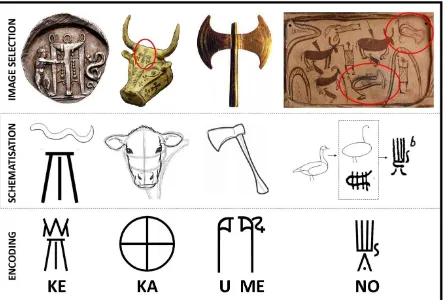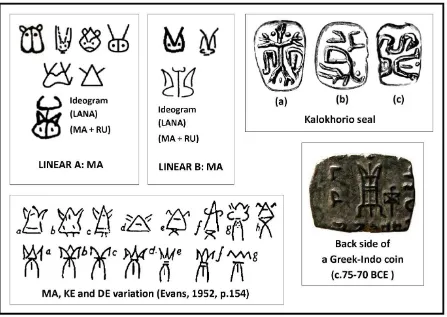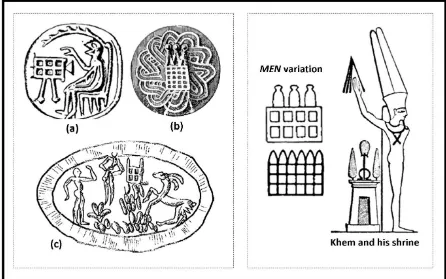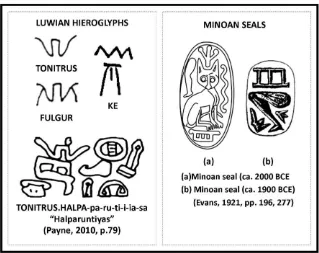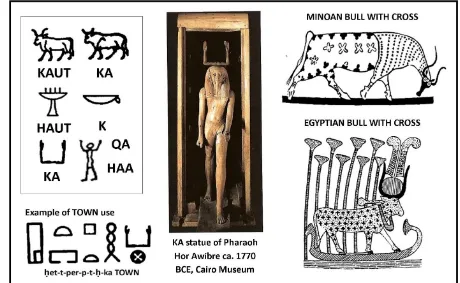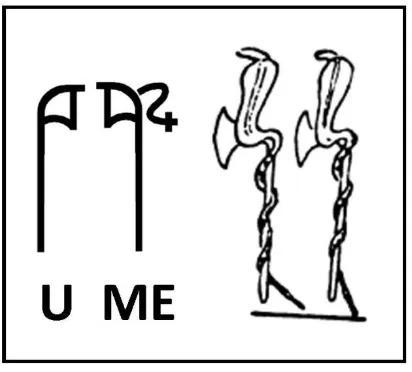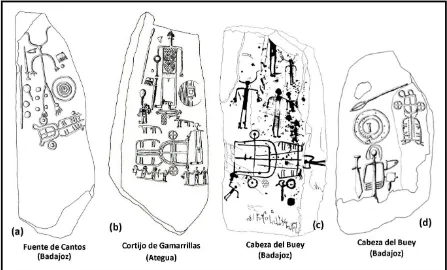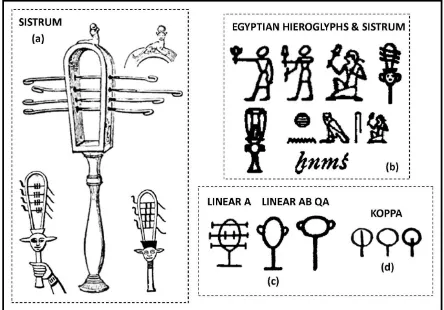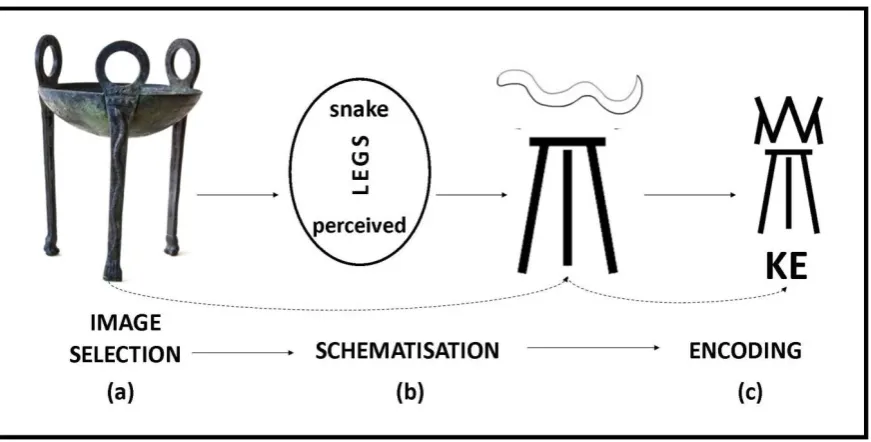The word ke-ka-u-me-no and its symbolic meaning in burial rites
Dr. Maria Mertzani, Research Associate
Centro de Letras e Comunicação, UFPEL, Pelotas – Brazil
Abstract
The Linear B word ke-ka-u-me-no is analysed through a non-arbitrary relationship between phoneme-grapheme-referent, following current research in sound symbolism (or language iconicity), which shows the direct linkage between certain phonemes to consistently represent visual, tactile or proprioceptive properties of objects, such as size or shape. The focus is on the “performative style” of language; that is, the symbols-graphemes of the word and its phonemes, in order to demonstrate the connection of ke-ka-u-me-no with sacrificial and burial processions in Minoan and Mycenaean periods. This analysis also demonstrates how the symbolism of the word is connected to its etymology, since, for example, its symbols have the exact same form as certain Minoan and Mycenaean decorative motifs on various artefacts, and in particular, on burial artefacts (e.g. on larnakes). In this paper, the symbols of ke-ka-u-me-no are compared with the iconography of the Hagia Triada sarcophagus and the Bronze Age Iberian stellae, as they depict common burial scenes and symbolism. In this comparison, linguistic and artistic evidence from Egyptian and Hittite (Luwian) civilisations is also brought forward in support of the connection. The paper also calls for interdisciplinarity, as there seems to be a growing consensus across disciplines that the forms of culture (linguistic, material, aesthetic, ritualistic, etc.) are connected to each other through cognition and metaphor.
Keywords: symbolism, language iconicity, ke-ka-u-me-no, Greek.
Please cite:
Mertzani, M. (November 1st, 2015). The word ke-ka-u-me-no and its symbolic meaning in burial rites. Paper at the conference Lingua e linguagem do mundo antigo – 30 de novembro e
4 de dezembro de 2015, Departamento em Historia de Universidade Federal do Rio Grande
Introduction
The Linear B word ke-ka-u-me-no (κεκαυμένος, burnt), which is met in the tablet PY 236=Ta 641 (Chadwick, 1958, p. 81), is analysed within a non-arbitrary relationship between its phonemes, graphemes and referent, following current research in sound symbolism (or language iconicity), especially in relation to velars, nasals, and the back vowels /a/ and /u/ (Magnus, 2001; Parise & Pavani, 2011; Perniss, Thompson & Vigliocco, 2010; Spector & Maurer, 2013) since these are its main constituents. Contrary to the Saussurean arbitrariness of sign that dominates contemporary linguistics, a connection between form, meaning and real-world referents is possible through symbolism1, occurring when content-free units convey meaning in certain linguistic contexts (e.g. in onomatopoeia) (Auracher, Albers, Zhai, Gareeva, & Stavniychuk, 2011; Perniss, Thompson & Vigliocco, 2010). Each object then can have an inherently correct name known from the object itself, from its denotata (Perniss, Thompson & Vigliocco, 2010). This relationship between referent, meaning and form is currently explained by the universality of symbol iconicity that serves the communicational function of encoding and decoding the information (Auracher et al., 2011, p. 4).
In this context, symbolism is orientated to the material of the natural world (e.g. to sounds, visual patterns, movements and rhythms). Therefore, the phonemes and graphemes of language are examined as a “perfomative style” of i.e. speaking, signing and writing, “consciously imitative,” in the form of schematic structures that are grounded in peoples’ bodily and perceptual experience. In this perspective, “utterances simulate the material qualities of the natural, sensible world and thereby articulate peoples’…cultural constructions of it” (Nuckolls, 1996, p. 3). Symbolism is then twofold, since natural language is materialised verbally i.e. in speech or signing, and in writing (Genette, 1994, p. 53). It is (i) phonemic, since it involves the phonemes of spoken and signed languages (vowels, consonants, handshapes etc.); and (ii) graphemic, since it refers to the grapheme, the written symbol of spoken languages. In this symbolism, analogy exists between the shape of phonemes and graphemes and their meaning. In (i), the phoneme is a variant of the concept, and “invariant over time … serially ordered, discrete, non-overlapping, static and drawn from a small enough set to be reliably produced and perceived” (Port, 2007, p. 155). In (ii), the graphemes are the written forms of phonemes and may adopt many graphic forms so as to cause a contrast of meaning (Crystal, 1993, p. 194). Thus, the graphemes function as symbols in lieu of real-world referents that may represent partly by similarity2 and partly by arbitrary convention (Nuckolls, 1996, p. 8).
It is then hypothesised that written words can be reduced to reference, demonstrating the connection phoneme - grapheme - referent through “verbal mimesis,” in which “things are made manifest through imitation3” (Genette, 1994, pp. 20-21). Thus, this paper focuses on graphemic imitation, according to which the symbols are understood as (i) imitation of the objects they designate, and (ii) as visual analogues of the phonemes they notate (p. 53). The word ke-ka-u-me-no as an example serves this objective. Moreover, this demonstration brings
1
This paper adopts the typology of symbolism by Hinton, Nichols and Ohala (1994, p. 1), in which “sound symbolism is the direct linkage between sound and meaning.” In particular, itconcerns the ‘synesthetic sound symbolism’, which is defined “as the acoustic symbolisation of non-acoustic phenomena”, “the process whereby certain vowels, consonants, and suprasegmentals are chosen to consistently represent visual, tactile, or proprioceptive properties of objects, such as size or shape” (p. 4).
2
For example, the Chinese ideograms convey their meanings (around 8%) through pictorial resemblances to their objects (Xiao & Treiman, 2012, p. 954).
3In particular, “[t]
the study very close to word etymology, since the choice of the necessary phonemes and graphemes for the fabrication of a word connotes a pictorial or graphic notion of imitation, which is “physically determined” by the nature and quality of its referent (Genette, 1994, p. 66).
The symbolism of ke-ka-u-me-no
The analysis of the word involves the analysis of (i) its graphemes (their morphological, phenotypic traits) and (ii) their corresponding phonemes. In (i), the graphemes are presented through a “close reading approach” that has been applied in the investigation of symbolism of highly visual languages such as sign languages (Kaneko & Sutton-Spence, 2011; Meir, 2010), and involves a detailed examination of the features of the symbols, their form and structure in the words, and their reference associations. In this approach, the researcher is reading “into” and “out of” the text – specifically “into” and “outof” the graphemic sequence of the word - so as to unveil its meanings. Where possible, the iconic properties of the graphemes are determined by their physical resemblance to their real-world referent. However, to avoid danger of arbitrary “free interpretation” (Kaneko & Sutton-Spence, 2011), data are supported by interdisciplinary referencing concerning (a) Linear AB scripts of Minoan and Mycenaean civilisation; (b) overall ancient symbolism (e.g. occult and artistic) in Greek and neighbouring civilisations (e.g. Egyptian, Hittite); and (c) current psycholinguistic research on the symbolism (or iconicity) of languages. Visual materials from (i) and (ii) are also provided to illustrate iconic properties, thus allowing readers to see how symbolism is manifested in the word.
The close reading approach also involves the three-stage analogue-building model (Taub, 2004, p. 44), for demonstrating the relationship between symbolism, semantics and referent. In this, there are three stages to follow: (I) the image selection of a mental image that is associated with the original concept/referent; (II) the schematisation of essential features of the image; and (III) the encoding of the resulting schema, using the appropriate Linear B symbol. The cognitive processes for each stage of the model can occur simultaneously.
“To create an iconic item, one selects an image to represent, modifies or schematizes
that image so that it is representable by the language, and chooses appropriate forms to show or encode each representable part of the image. Moreover, when modifying the image or “translating” it into linguistic form, one makes sure that the new image preserves the relevant physical structure of the previous stage… this model is not intended to represent what goes on in a language user’s mind each time he or she utters an iconic item. This is a model for the creation of iconic items; once created, these items can be stored and used just like any other linguistic item … these items can also be modified by language-internal morphological processes such as compounding” (ibid.).
Figure 1 illustrates the making of ke-ka-u-me-no according to the specific model, whose syllable order is discussed to associate with sacrificial and burial rituals. Explanations of the depicted associations are presented in the following section.
Symbols and referents of ke-ka-u-me-no
Figure 1: The three-stage analogue-building model of ke-ka-u-me-no
KE. For the analysis of this symbol the following sources were taken into consideration. Firstly, its graphemic variation (Evans, 1952, p. 154) (Figure 2) that shows KE to be consisted of two parts; (a) the upper part that sometimes resembles of a cat’s head, and other times as a cone/omphalus with a snake coiled around it; and (b) the lower part that represents man’s genitals and feet. Regarding (a), evidence comes from the variation of the syllable MA that represents a cat’s head in Linear AB scripts (Davis, 2011, p.56), which, in turn, appears on Minoan seals as a shrine (Marinatos, 1993, p. 173) (Figure 3, c). Concerning (b), proof is available on an Early Minoan I (EMI) seal (ca. 3200 BCE) from Kalokhorio, in Crete-Greece (Evans, 1909, p. 116; 1921, p. 68), where on side (a) a man is shown with outstretched arms, and on side (c), his genitals and feet, accompanied by a snake (Figure 2). This specific side and scene resembles the grapheme KE, denoting also the masculinity of the symbol. In particular, it is the symbol numbered g from Evans’s KE variation that seems to represent both the lower part of the male figure and the snake on its upper part.
Hence, on the basis of these two sources, KE appears to relate to cult centres, such as the Minoan shrines, where devotees adopted particular upraised arm posture of worship, as the iconography of various Minoan palace processions shows (Marinatos, 1993, pp. 52-53). There is also the famous Minoan female idol, the Goddess with the snakes, which also agrees with the depicted scene of the seal and its serpentine theme. According to Evans (1901, p. 118) and Cook (1925, pp. 193-195), tripod-lebes had been developed from Minoan sacred shrines, therefore connecting its anthropomorphic4 features (the male genitals and feet) with
4
the base of the tripods that usually were lions’ feet, and/or coiled serpents. The iconography of ancient coins, such as of the Roman coins with the inscription ΚΟΙΝΟΝ ΚΡΗΤΩΝ5 (Evans, 1901, p. 116), and the one on the Greek-Indo coin of Apollodotos II (c.75-70 BCE) (Figure 2) clearly displays this relationship among the male figure, the tripod and the Minoan shrine with the Linear B MA and its ideogram (LANA). Moreover, a plethora of archaeological artefacts shows the Minoan shrine with cup-like hollows on its top (pp. 115-118) that correspond to the vessel of the tripod for the reception of offerings.
Figure 2: Figurative associations among KE and MA
Furthermore, Evans (1921, p. 69) linked the male figure of the Kalokhorio seal to a bull-headed one on an EMI whorl from Hagios Onuphrios deposit in Crete, and to similar Minotaur-like figures on prehistoric Egyptian seals, thus reminding of the bull and its sun worship (Banou, 2008, p. 31).
The connection of KE with the shrine (and therefore with the tripod-lebes) is also depicted on the shrines of Khem/Khemu6 (Goldsmith, 1924, p. 12; Wilkinson, 1878, pp. 404-405), whose trees are proportionate to the phenotypic traits of MA (e.g. the trees as cat’s ears)
5“The table itself is here surmounted by a central akroterion, and lateral excrescences which represent here, as
elsewhere, the tradition of the typical cult object of Mycenaean times, 'the horns of consecration'” (Evans, 1901, p. 116).
6
(Figure 3). Furthermore, the tree over the shrine is a repetitive motif on numerous Minoan seals that Evans (1921, p. 125) compared with the Egyptian sign men. Specifically, its quadripartite design is found on EMI seals (p. 124) and ivory signet (p. 125) (Figure 3, a, b), signifying the association of the shrine with the earth, its division and irrigation.7
Figure 3: The shrine and its earthen symbolism in Minoan Crete and Egypt
This quadripartite design is also present in the Luwian hieroglyphic combination TONITRUS.HALPA for the construction of theophoric names referring to a storm-god (Yakubovich, 2013) that strongly resembles to Minoan Zeus of the Diktaean Cave. Firstly, TONITRUS (thunder) represents the serpent and thus associating with the upper part of KE, and secondly, HALPA corresponds to the lower part of KE as the ‘foot’ of the shrine (Figure 4). In fact, HALPA appears to be a loan since it is an exact imitation of Middle Minoan I seal symbolism (ca. 2000 BCE). A characteristic example that summarises the aforementioned symbolism is a Minoan seal of a cat sitting on a shrine, while being surrounded by a serpent and a foot. Furthermore, similar to TONITRUS is the hieroglyph FULGUR (lightning) (Çambel, 1998, pp. 90, 92), which also resembles the upper part of KE.
KA. This symbol (Figure 5) strongly relates to bull worship and it falls in the life-cycle symbolism (Gimbutas, 1982, p. 89); that is, the symbolism of the earth, the sun and moon; the rotation of seasons, the vegetal life-cycle, the birth, growth and death. It is met in early
7
Neolithic (Gimbutas, 1982; Marangou, 2001; Merlini, 2011), representing (i) the sun, “the supreme creator, fructifier of earth, regulator of the seasons and diurnal time,” and (ii) the moon, the Great Mother, the personification of the female, “dividing into smaller and more comprehensive periods, the larger measures of time, defined by the Solar orb” (Higgins, 1912, p. 13). Thus, the four small squares (that are also depicted on MA; cf. Figure 3) represented the four phases of the sun, between the periods of its greatest heat (p. 17), and KA, as the bull/cow, represented the noon (Banou, 2008: 31), the midday sun (Cook, 1914, p. 254). Apart from its direct correspondence to the round shape of the sun and the moon, KA also stands for the head of the bull/cow. This relationship is more evident if one follows the steps of drawing the animal’s head8
, where the baseline perception is round (Arnheim, 1974).
Figure 4: Luwian TONITRUS.HALPA and Minoan symbolism
Evans (1895, p. 43; 1909, p. 183) related the encircled cross (especially its variant, the concentric cycle) to the Cretan eye hieroglyphs, which were also regarded solar and stellar signs. These, in turn, bore close resemblance to the Egyptian eye hieroglyphs of Ra that symbolised the sun (Budge, 1973, pp. 55-56; Evans, 1895, p. 43). Hence, KA represented both the sun, as the bull signifying the pubic triangle9, and the concentric boundaries of land (Lonegren, 1996, pp. 35-36). Especially in the form of a labyrinth (usually of five concentric cycles), KA was connected with both the sun and water, representing an androgynous symbol of self-creation (Goldsmith, 1924, p. 24). Earth, the feminine principle, was then fecundated by the waters, the serpent, the personification of the male principle (Elworthy, 1895, p. 187; Parsons, 1896, p. 61). Furthermore, as an earth symbol, KA represented the ground plan of a town (Mertzani, 2015a; 2015b), likewise the determinative hieroglyph ‘town’ (Budge, 1973, p. 76) that used to accompany the names of Egyptian cities. Figure 6 illustrates the overall association of the cross with the sacred cow/bull in Minoan and Egyptian civilisations.
8
The encircled cross also stands for the cat’s head since it is the baseline form of MA.
9
Additionally, the hieroglyphs of a bull/cow, upraised arms and a vessel/shrine had the same phonetic value with KA.
Figure 5: Linear AB KA and its variation
Figure 6: KA in Egyptian hieroglyphs
of wood,
“which were laid cross-wise upon one another before the sacrificial altars in order to produce the holy fire, and whose ends were bent around and fastened by means of four nails, so that this wooden scaffolding might not be moved. At the point where the two pieces of wood were joined, there was a small hole, in which a third piece of wood in the form of a lance was rotated by means of a cord made of cow's hair and hemp, till the fire was generated by friction.…the Greeks for a long time generated fire by friction, and that the two lower pieces of wood that lay at right angles across one another were called ‘σταυρός’ …” (McAdams, 1887, p. 67).
U and ME. In Minoan and Mycenaean times the head of a bull (especially its horns) was
closely connected to altars (Marinatos, 1993, p. 5) and sacrifices10 (Evans, 1909, p. 206), therefore a double axe was usually portrayed between its horns (Gimbutas, 1982, p. 186). The meaning of the axe was allied to the thunderstones (in Greek: τό κεραύνιον), the “bolts of heaven” that were recognised as the stone axes (Evans, 1901, p. 118). In ke-ka-u-me-no, the double axe is denoted by the two syllables U and ME (cf. Evans, 1952, p. 155) whose baseline grapheme is the same but with a single difference; the pole of ME is accompanied by a serpent, likewise in Egyptian axes (Budge, 1895, p. 277) (Figure 7). This symbolism of U as an axe and thus, a tool is later met in Greek in the suffix –εύς that used to indicate occupational names of agents and instruments, and to express “one who has to do with the basic noun” (Palmer, 1980, pp. 249-250).
Figure 7: Axe associations
NO. The last syllable NO, based on Evans (1952, p. 154) variation, represents a bird that during the Minoan period signified fertility and rebirth (Marinatos, 1993, pp. 138-139). The bird was a frequent motif on many artefacts such as on larnakes, vessels and seals, on which its body formed an ostrich's egg (Evans, 1921, p. 237). In close relation to this meaning and the value /no/, stands the creation myth of Egyptian sun worship according to which “the world was in the beginning a waste of waters called Nu. Nu gave being to the sun-god who appeared first as a shining egg floating on the waters” (Goldsmith, 1924, p. 11). Apart from the egg, the iconography of larnakes, as for example the one from Armenoi where the birds are part of a sacrificial scene (Watrous, 1991, p. 300), depicts the bird to associate with stringed musical instruments, such as the lyre. For this latter relation Marinatos (1993, p. 140) argued that,
10
“[m]usical instruments, perhaps because they are thought to imitate the sounds of birds, are often the tools of the shaman. If the gods cannot be present themselves, they send their celestial messengers as assurance of their goodwill. Behind the later Greek mythical figure of Orpheus, who enchanted animals with his lyre music, almost certainly lies the cultic reality of a priestly figure.”
Elsewhere, the birds are depicted over the shrines and seated (usually on the pillars of the shrine), symbolising the descent of the divinity. On the sarcophagus of Hagia Triada the birds are “brought down by ritual strains and libations on to the sacred Double Axes, which are thus charged as it were with the divinity” (Evans, 1921, p. 223).
“This possession is often marked by soothsaying and ecstatic dances, and an orgiastic dance on a Late Minoan signet ... Musical strains such as those of the lyre or the conch-shell or the sistrum of Egyptian cult were a means of invocation.” (p. 224)
In Greek the suffix -νο- is met in temporal adjectives (e.g. χειμερινός: relating to winter; θερινός: relating to summer), therefore denoting the connection of the syllable to rebirth and seasonal renewal. It is also met in certain “fossil formations derived from verbs” as in the verb καίω (= to burn) and its cognates (e.g. καίνω: slay; καινόω: make new, change, renew; καίνυμαι: overcome, to be adorned, equipped) (Palmer, 1980, pp. 255, 258), whose etymology is based on ke-ka-u-me-no and its corresponding graphemic symbolism.
Figure 8: Iconography from Hagia Triada sarcophagus
Connections to Bronze Age burial processions
another one carries baskets (Figure 8, (a)). Secondly, on the back, it corresponds to the scene where a procession of women accompanies a sacrifice of a bull, and a woman who makes an offering in front of an altar decorated with an S-pattern and a tree (Figure 8, (b)). Although on the sarcophagus two libation scenes are saved and depicted, Evans (1901, p. 113) argued about a triple libation that was probably taken place in Minoan cult, similar to the old Arcadian rite offering to the Dead before the falls of Stynx.
KA corresponds to the scene of the slain bull, where the animal is cross-tied on a sacrificial table/or altar, and blood flows from its neck into a vessel. U and ME correspond to the double axes with the two birds on top of them; and NO, primarily to the scene of a figure (male) playing a seven-stringed lyre, and secondly, to the large flying bird. Each end panel features a pair of chariot-borne goddesses (Figure 8, (c)).
Figure 9: Iberia stellae and burial processions
hands in front of the chariot, thus reminding of the Khalochorio figure and its KE symbolism. Additionally, on the Cortijo de Camarrillas stella, on the leg of the small figure is attached a men-like pattern, similar to Luwian HALPA and its Minoan prototypes. Furthermore, axe-like figures also appear (e.g. an axe is shown next to the horned head of the Fuente de Cantos stella) that may correspond to U and ME.
The shape of the chariot is also comparable to the lyre of the sarcophagus and to the symbolism of NO. Parallel to the procession of Hagia Triada, the Cortijo de Camarrillas stella displays six figures with holding hands and axes (?) that remind of ritual dancing and musical strains such as of a stringed lyre and/or a sistrum. Regarding the latter, Wilkinson (1878) provided the following detail that connects sistrum with MA and the Minoan shrine as the double11 ‘horns of consecration’ (Banou, 2008, p. 33). On the convex surface, the sistrum was used to symbolise the cat with a human visage, and on the lower part, under the moving cords, the face of Isis, the cow (Wilkinson, 1878, p. 497). On each of its three bars that resemble the three horizontal lines of the chariot, were three or four metal rings that, when shaken, created a rattling noise that imitated snakes. This description and the shape of the sistrum also remind of the Linear AB QA that had the value /ka/ as well (Figure 10).
Figure 10: The sistrum in Egyptian hieroglyphs and its association to QA
It is this rattling function of the sistrum that indirectly connects to NO and its bird symbolism. Interestingly, this relationship is more evident on early Neolithic artefacts, where the snake and the bird appear simultaneously as a single divinity (e.g. on anthropomorphic
11
idols that have horned heads and bird-clawed or snake-like hands like the figures on the Iberian stellae), since they both relate to water and the Mother Goddess cult (Gimbutas, 1982, pp. 101, 112). The universal snake “winds around the universal egg like a continuous flow of water” (p. 95) and the bird is the carrier, the container of the egg and water (p. 112).
“Their functions are so ultimately related that their separate treatment is impossible. She is one and she is two, sometimes snake, sometimes bird. She is the goddess of waters and air, assuming the shape of a snake, a crane, a goose, a duck, a diving bird. The combination of a water snake and a water bird is a peculiarity … representing divine ambivalence.” (Gimbutas, 1982, p. 112)
It is also the case that the shape of the instruments12 functioned as visual metaphors of i.e. the cat, the bull/cow, the snake, the bird and their intertwined symbolism. For example,
chnoue (χνόη, Ion. χνοίη) was another instrument to have been used by the Greeks at
sacrifices similar to sistrum (Wilkinson, 1878, p. 499). This was also called ὁ κνόος (and/or κνόη) that literally meant the ‘axle-box, nave,’ therefore reminding of the egg and the omphalus; the ‘sound of footsteps’ and ‘the joints on which the feet play, as the wheels on the axle’ (LSJ), thus strongly associating with the wheel, the foot (cf. HALPA) and the sacred shrine. Allied to this symbolism of the sistrum and/or χνόη is the hieroglyphic word ĥnmś (Gardiner, 2001, p. 443), whose determinative is a seated figure that holds the sistrum. This word, in turn, strongly relates to κνημαῖος < ἡ κνήμη13 (Dor. κνάμα) that also meant the leg and the spoke of a wheel (LSJ).
More likely though the chariot is linked to the lyre, since on the Iberian stellae small items like sistrum also appear (cf. (a) and (d), Figure 9) next to the anthropomorphic figures. In addition, the lyre is connected to the orphic myth of creation, according to which the Night (in Greek: ἡ νύξ; cf. the Egyptian myth of Nu above), as a great black-winged bird, existed first and laid an egg from which Ouranos (the sky; the Milky Way) and Gaia (the earth) were created. Both the sky and earth were represented by the quadripartite square, which in Linear B also appears in the syllable NU and in the word o-nu-ka for the Homeric ὁ ὄνυξ that primarily meant ‘the talon of the eagle’. In particular, NU is represented by a cycle (the egg) enclosed in the square, a pattern that was frequently used since early Neolithic, blending the snake with the cosmic egg (Gimbutas, 1982, pp. 103, 167). Hence, both NO and NU, associate with the bird, the orphic myth of creation, and the lyre of Orpheus.
Discussion and conclusion
The above analyses demonstrate that the symbols of ke-ka-u-me-no associate with the Minoan and Mycenaean culture, and even earlier, with Greek Neolithic. To present (2015), the symbols of ancient scripts have been approached in isolation and with no contact with their broader cultural and historical context, due to the fact that, overall, the humanities sciences have been traditionally considering their objects of study (e.g. historical linguistics) autonomous phenomena that can be documented, described, and analysed as isolated bits of
12
Other examples are the crotala (τόκρόταλον), the clapper used in the worship of Cybele, of Dionysus, and generally, in dances or crembala (τά κρέμ λα) or cymbals (τό κύμ λον < κύμ ος = κύμ η, cup), which were connected to the mythical birds of Stymphalus, since the latter, as “Pisander, of Camirus, affirms … were frightened away by the noise of crotala” (Wilkinson, 1878, p. 494). The crotala of the ancient Egyptians were sometimes terminating in a human head similar to the one of sistrum, and of the Greeks, as they appear on vase paintings, were of a flat shape, resembling a bell (ibid.). In a sacrifice to Isis at Herculaneum, in company with several sistra, there was “an instrument consisting of a rod and a set of movable balls, arranged in a circle, apparently shaken by the performer; who, in the other hand, holds four links of a chain, intended, no doubt, to emit a similar jingling sound” (p. 498).
13
information (Danesi, 2013). Thus, for example, the Linear B script is being studied away from Minoan and Mycenaean art, where decorative motifs have been found to have the exact same form as the graphemes of the script, as well as the graphemes of neighbouring scripts (e.g. Egyptian and Luwian hieroglyphs). However, there seems to be a growing consensus across disciplines that the forms of culture (linguistic, material, aesthetic, ritualistic, etc.) are connected to each other in some way thanks to a cognitive mechanism of conceptual metaphor (p. 37).
The symbols of ke-ka-u-me-no, in the order they appear, demonstrate their connection to sacrificial and burial processions in Minoan and Mycenaean periods, whose parallels are traced in the Mediterranean i.e. in ancient Egypt and Bronze Age Iberia. In this examination, information from epigraphy and historical linguistics was associated with the iconography of various paintings (e.g. on vases and larnakes), and with cultural narratives (e.g. mythology of creation), so as to display graphic similarities, signification and referentiality. Moreover, following the three-stage analogue-building model of the word, it is shown that the symbols, as the internal structures of the language, “are pliable entities…responsive to external social situations” that focus on the figurative reasoning of language (p. 37). For instance, the graphemic form of KE, U, ME and NO has preserved the relevant physical structure of those items that were in use during the Minoan and Mycenaean periods (e.g. the tripo-lebes and the axe), whereas KA, although its round and abstract shape did not directly represent the properties of the bull/cow, its symbolic connotation of the sun permitted its symbolic relation to the animal. In addition, this correspondence is tenable based (i) on psychology and arts that demonstrate the perception of the head (of a human and/or of an animal) primarily as a cycle (Arnheim, 1974); (ii) on archaeological artefacts (e.g. the head of a bull as rhyton with a cross on its forehead; the bull with the sun among its horns), and (iii) on epigraphic evidence (e.g. the head of a bull and/or the bull/cow to represent certain phonemes as /ka/).
These connections are further supported by current research on sound symbolism, which indicates a geometric relationship between sound and meaning, when, for example, laterals and nasals with back vowels (e.g. /o/, /a/) like in pseudowords ‘maluma’ or ‘bouba,’ connect to round shapes and soft-looking forms (Spector & Maurer, 2013; Spence & Deroy, 2012). In Antuñano’s study (2006), cyclical motion was indicated when imitative words (e.g. ‘bira -biraka’= twirling; ‘firri-farraka’= rolling) were articulated with laterals and velars with back vowels. Similarly, in Japanese, the rolling motion is expressed through a combination of velar and lateral consonants with /o/ (e.g. goro: heavy object rolling; koro: light object rolling; gorogoro and korokoro for repetitive rolling motion) (Perniss, Thompson & Vigliocco, 2010, p. 3). In English, Magnus (2001, pp. 59-65) indicated the velar /k/ to associate with roundness, and in particular with the meanings of “closure, containers and crevasses.” Moreover, in the study of Parise & Pavani (2011) the vocalisation of /a/ was linked to dodecagons (which approximate cycles), and therefore to round-like referents.
In line with these studies and in relation to the symbolism of ke-ka-u-me-no, KE and KA connect to a container (the tripod-lebels) and to a head/sun, and thus to round/round-like real-world referents. Additionally, NO as a nasal sound with /o/, is linked to a bird and thus, to a soft-looking form (due to its feathers), and to an egg that also has a round shape form. With regards to U and ME, a possible explanation might be their connection to the handling of the axe, of its cylindrical pole (rather than to its sharp and angular edge), likewise in signed languages, where the closed fist handshape (therefore a round phoneme) occurs in the “handling” verbs14 (Shembri, 2003, p. 22). The fact that both /me/ and /no/ appear in a word
14
that expresses “burning” (and thus, death; cf. also /no/ and /nu/ for the concepts of “darkness” and “night” in myth creations), corroborates with the findings of Auracher et al. (2011) that the nasals can, in a parallel way, express feelings of sadness and passivity. Moreover, since all the symbols of the word connect to roundness, phonemically and graphemically, it is also tenable to argue that ke-ka-u-me-no is a linguistic demonstration of perceiving and expressing the concept of “fire”and “burning” as round.
This position is further supported by examining the combination of the symbols (a) KE, KA and U in the sequence ke-ka-u and/or ka-ke-u; and (b) ME and NO in the sequence me-no, as they have been preserved in Homeric and later forms of Greek. Interestingly, this examination indicates that these combinations strongly connect with concepts, referents and experience regarding the sacrifice, the burial, the bird and the worship of a female divinity, which, to some extent, also relate to roundness.
Starting with (a), some of the following words carry the meaning of the hollow shape (the cavity) of the tripod-lebes and the bubbling of the water/blood, therefore indicating their connection to roundness (and sacrifice). Some others mean the cutting and/or mischief,
birds and their onomatopoetic sounds: ἡ κήξ: a sea-bird, the tern or sea-swallow (cf. καύαξ, καύηξ, κῆϋξ); ἡ κίκκα: hen; κικκ αῦ, onomatop., cry in imitation of the
In fact, the figurative form of the Linear B velars (e.g. KA-QA, KI-QI, KE-QE, KO-QO, KU) also connects to the above meanings (of a bird, a cow/bull, a dagger/axe, a vessel etc.) and to the Minoan and Mycenaean cult worship (e.g. of the Mother Goddess), since they actually represent such concepts (e.g. QA is a head; KU is a bird; QO is a vessel). This relation also allows the speculation that their combinations in the words was not arbitrary but intentional, allied to their historic and cultural context. For example, the existence of KA in ke-ka-u-me-no and in relation to fire can be also seen in the round shape of the hearth, which was central in Minoan and Mycenaean palaces; and/or in relation to the round burial ground of the tholos tombs in the middle of which the bodies were placed.
With regards to (b), the sequence correlates with the concepts of fierceness and therefore with the symbolism of the axe, as well as with the moon and the month (and thus, with roundness), with priesthood (e.g. Minos) and divinities (e.g. Ariadne) that strongly relate to the myth of the Minotaur and the labyrinth, and therefore with the aforementioned associations with the bull/cow and the horned figures. For example, there are words that express:
strength, force, fierceness, life and soul: τό μένος: force, strength, fierceness, spirit, life, intent, purpose.
passivity, awaiting and the state of staying: μένω, stay, wait: of things, to be lasting, remain (cf. μίνω Arc. for μένω).
the moon (as a divinity as well) and the month: ὁ μείς and μήν: moon, the crescent moon, the part of the month corresponding to a phase of the moon, the visible part of the moon, ornament in form of crescent moon; ἡ μήνη: moon; Μήν (Μείς): an Anatolian divinity (Lydia); ὁμείς (gen. μηνός): month, on the fourth day from the end of the month, the last of the month, at the end of the lunar month (when there was no moon-light).
μηνύω: disclose what is secret, reveal; generally, make known, declare.
ὁΜίνως: Minos; Adj. Μ ν ος, α, ον (Att. Μ νῷος, Μινῷος), name of fictitious month; fem. ἡ Μ νω ς; nymph, i.e. Ariadne.
The word ke-ka-u-me-no is an example of how language and culture are intrinsically intertwined and how phonemic and graphemic symbolism, in relation to archaeological artefacts, can be used to enhance word etymologies, as they add information about the formation and meanings of the word roots. A ritual such as a sacrificial burial, relevant archaeological artefacts, and language phonemes and graphemes, are connected semiotically, allowing scholars “to investigate more specifically how language, symbolism, artistic practices, social rituals, and all the other forms of meaning making constitute a connective system of meaning through figurative cognition” (Danesi, 2013, p. 41). Its analysis is also a call for re-examining the grapheme-phoneme relationship, diachronically and historically, and through the use of interdisciplinarity.
Appendix A:
The analogue building model for each Linear B syllable of ke-ka-u-me-no
Figure A1: Analogue building process of the Linear B KE, showing (A) the initial, prototypical image of a tripod-lebes, (B) the image schematised to fit KE’s characteristics, and (C) the image encoded as KE.
Figure A3: Analogue building process of the Linear B U and ME, showing (A) the initial, prototypical image of an axe, (B) the image schematised, and (C) the encoding of U and ME.
References
Antuñano, I.I. (2006). Ttipi-Ttapa Ttipi-Ttapa... Korrika!!! Motion and Sound Symbolism in Basque. Anuario del Seminario de Filología Vasca Julio de Urquijo:
International journal of basque linguistics and philology, 40 (1-2), 499-518.
Arnheim, R. (1974). Art and visual perception: a psychology of the creative eye. palatial and post-palatial Crete? Mediterranean Archaeology and Archaeometry, 8 (1), 27-47.
Bayley, H. (1952). The lost language of symbolism. Volume I. New York: Barnes and Noble Inc.
Budge, E.A.W. (1895). The book of the dead. The papyrus of Ani in the British Museum. London: Harrison and Sons.
Budge, E.A.W. (1973). Egyptian Hieroglyphic Reading Book for Beginners. United States of America: Dover Publications.
Çambel, H. (1998). Corpus of Hieroglyphic Luwian Inscriptions: Karatepe-Aslantaş: the
inscriptions, vol II. Berlin, New York: de Gruyter.
Chadwick, J. (1958). The decipherment of Linear B. The key to the ancient language and
culture of Crete and Mycenae. New York: Cambridge University Press.
Chadwick, H. (1973). Documents in Mycenaean Greek. Cambridge: Cambridge University Press.
Cook, A.B. (1914). Zeus. A study in ancient religion. Volume I:Zeus god of the bright
sky. Cambridge: Cambridge University Press.
Cook, A.B. (1925). Zeus. A study in ancient religion. Volume II: Zeus god of the dark sky
(thunder and lightning). Cambridge: Cambridge University Press.
Crystal, D. (1993). The Cambridge encyclopaedia of language. Cambridge: Cambridge University Press.
Danesi, M. (2013). On the metaphorical connectivity of cultural sign systems. Signs and
Society, 1(1), 33-49.
Davis, B. (2011). Cypro-Minoan in Philistia? Kubaba, 2, 40-74.
Dietrich, B.C. (1997). Death and afterlife in Minoan religion. Kernos, 10, 19-38.
Elworthy, F.T. (1895). The evil eye. An account of the ancient and widespread
superstition. London: John Murray.
Evans, A.J. (1895). Cretan pictogrpahs and prae-phoenician script with an account of a sepulchral deposit at Hagios Onuphrios near Phaestos in its relation to primitive Cretan and
Aegean culture. London, New York: Bernard Quaritch –G.P. Putnam’s Sons.
Evans, A.J. (1909). Scripta Minoa. The written documents of Minoan Crete with special
reference to the archives of Knossos. Volume I: the hieroglyphic and primitive linear classes.
Oxford: Clarendon Press.
Evans, A.J. (1921). The palace of Minos at Knossos. Volume I: the Neolithic and early
and middle Minoan ages. London: MacMillan and Co. Ltd.
Evans, A.J. (1952). Scripta Minoa. The written documents of Minoan Crete with special
reference to the archives of Knossos. Volume II. Oxford: Oxford University Press.
Gardiner, A. (2001). Egyptian grammar. Being an introduction to the study of
hieroglyphs. United Kingdom: Cambridge University Press.
Gardner, P. (1896). A stone tripod at Oxford. Journal of Hellenic Studies, 16, 275-280.
Genette, G. (1994). Mimologics. London: University of Nebraska Press.
Gimbutas, M. (1982). The goddesses and gods of Old Europe 6500-3500 BC. Myths and
cult images. Great Britain: Thames and Hudson.
Gimbutas, M. (1989). The language of the goddess. San Francisco: Harper and Row Publishers.
Goldsmith, E.E. (1924). Life symbols as related to sex symbolism. New York, London: The Knickerbocker Press.
Higgins, F.C. (1912). The cross of the magi. New York: Roger Brothers.
Hinton, L., Nichols, J., & Ohala, J. (1994). Introduction: sound-symbolic processes. In J.J. Ohala, L. Hinton, & J. Nichols (Eds.), Sound symbolism (pp. 1-14). Cambridge: Cambridge University Press.
Jaffe, A. (1964). Symbolism in the visual arts. In C.G. Jung (Ed.), Man and his symbols (pp. 255-322). New York: Dell Publishing Co. Inc.
Kaneko, M., & Sutton-Spence, R. (2012). Iconicity and metaphor in sign language poetry. Metaphor and Symbol, 27(2), 107-130.
Lonegren, S. (1996). Labyrinths: ancient myths and modern uses. Glastonbury: Gothic Images Publications.
Magnus, M. (2001). What’s in a word? Studies in phonosemantics. PhD Thesis, Norwegian University of Science and Technology, Trondheim, Norway.
Marangou, C. (2001). Evidence for counting and recording in the Neolithic? Artefacts as signs and signs as artefacts. In A. Michailidou (Ed.), Manufacture and measurement.
Counting, measuring and recording craft items in early Aegean societies (pp. 9-43). Athens:
Research Centre for Greek and Roman Antiquity, National Hellenic Research Foundation.
Marinatos, N. (1993). Minoan religion. Ritual, image and symbol. Columbia, South Carolina: University of South Carolina Press.
McAdams, W.M. (1887). Records of ancient races in the Mississippi valley. Being an account of some of the pictographs, sculptured hieroglyphs, symbolic devices, emblems and
traditions of the prehistoric races of America, with some suggestions as to their origin. St.
Louis: C.R. Barns Publishing Co.
Merlini, M. (2011). A comparison between the signs from Tartaria, the Danube script and other early writings. In: C. Lazarovici, G. Lazarovici, M. Merlini, & J. Marler (Eds.),
Tartaria and the Sacred Tablets (pp. 263 – 337). Rome, Italy: Euro Innovanet Srl. Italy –
Institute of Archaeomythology.
Mertzani, M. (2015a). Roundness in spoken and signed languages. Paper presented at the “II Seminario Linguas em contato: onde estao as fronteiras?”- 2-3 October 2015. UFPEL/CLC/PEIF, Pelotas – RS, Brasil. October 3.
Mertzani, M. (2015b). Symbolism of the encircled cross in Greece and Egypt. Working Paper presented at the XVI Jornada de História Antiga-Além das fronteiras: contatos interculturais no Mediterrâneo Antigo, 24-28 August 2015. Laboratório de Estudos sobre a Cerâmica Antiga (LECA) - Polo Interdisciplinar de Estudos do Mundo Antigo (POIEMA), UFPel, Pelotas, Brazil. August 27.
Niolaki, G.Z., & Masterson, J. (2012). Transfer effects in spelling from transparent Greek to opaque English in seven-to-ten-year-old children. Bilingualism: Language and
Cognition, 15 (4), 757–770.
Nuckolls, J.B. (1996). Sounds like life. Sound-symbolic grammar, performance and
cognition in Pastaza Quechua. New York, Oxford: Oxford University Press.
Palmer, L.R. (1980). The Greek language. London: Faber and Faber Ltd.
Parise, C.V., & Pavani, F. (2011). Evidence of sound symbolism in simple vocalizations.
Exp Brain Res, 214(3), 373-380.
Parsons, J.D. (1896). The non-Christian cross. London: Bemrose and Sons Ltd.
Payne, A. (2010). Hieroglyphic Luwian: an introduction with original texts. Wiesbaden, Germany: Harrassowitz Verlag.
Perniss, P., Thompson, R.L., & Vigliocco, G. (2010). Iconicity as a general property of language: evidence from spoken and signed languages. Frontiers in Psychology, 1, 227.
Port, R. (2007). How are words stored in memory? Beyond phones and phonemes. New
Ideas in Psychology, 25, 143–170.
Shembri, A. (2003). Rethinking “classifiers” in signed languages. In K. Emmorey (Ed.),
Perspectives on classifier construnctions in sign languages (pp. 3-34). U.S.A.: Laurence
Erlbaum Assoviates, Inc.
Santos, M.J. (2009). Estelas diademadas. Revisión de criterios de clasificacion.
Herakleion, 2, 7-40.
Spector, F., & Maurer, D. (2013). Early sound symbolism for vowel sounds.
i-Perception, 4, 239–241.
Spence, C., & Deroy, O. (2012). Hearing mouth shapes: sound symbolism and the reverse McGurk effect. i-Perception, 3, 550–552.
Werness, H.B. (2003). The continuumencyclopaedia of animal symbolism in world art. U.S.A.: The Continuum International Publishing Group Inc.
Wilkinson, J.G. (1878). Manners and customs of the ancient Egyptians. New York: Dodd, Mead and Company Publishers.
Xiao, W., & Treiman, R. (2012). Iconicity of simple Chinese characters. Behavior
Research Methods, 44(4), 954-60.
Yakubovich, I. (2013). Anatolian names in –wiya and the structure of empire Luwian onomastics. In A. Mouton, I. Rutherford, & I. Yakubovich (Eds.), Luwian Identities.
Culture, language and religion between Anatolia and the Aegean (pp. 87-124). Leiden,
Boston: Brill.
Online resources:
